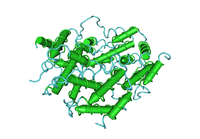
Interferon type II
Encyclopedia

Interferon-gamma
Interferon-gamma is a dimerized soluble cytokine that is the only member of the type II class of interferons. This interferon was originally called macrophage-activating factor, a term now used to describe a larger family of proteins to which IFN-γ belongs...
(gamma). Mature IFN-γ is an anti-parallel homodimer, which binds to the IFN-γ receptor (IFNGR) complex to elicit a signal within its target cell. IFNGR is made up of two subunits each of molecules designated IFNGR1 and IFNGR2.
Sources and functions
IFN-γInterferon-gamma
Interferon-gamma is a dimerized soluble cytokine that is the only member of the type II class of interferons. This interferon was originally called macrophage-activating factor, a term now used to describe a larger family of proteins to which IFN-γ belongs...
is involved in the regulation of the immune and inflammatory responses; in humans, there is only one type of interferon-gamma. It is produced in activated T-cells and natural killer cell
Natural killer cell
Natural killer cells are a type of cytotoxic lymphocyte that constitute a major component of the innate immune system. NK cells play a major role in the rejection of tumors and cells infected by viruses...
s. IFN-γ has some anti-viral and anti-tumor effects, but these are generally weak. However, this cytokine
Cytokine
Cytokines are small cell-signaling protein molecules that are secreted by the glial cells of the nervous system and by numerous cells of the immune system and are a category of signaling molecules used extensively in intercellular communication...
potentiates the effects of the type I IFNs. IFN-γ released by Th1 cell
T helper cell
T helper cells are a sub-group of lymphocytes, a type of white blood cell, that play an important role in the immune system, particularly in the adaptive immune system. These cells have no cytotoxic or phagocytic activity; they cannot kill infected host cells or pathogens. Rather, they help other...
s recruits leukocytes to a site of infection, resulting in increased inflammation. It also stimulates macrophage
Macrophage
Macrophages are cells produced by the differentiation of monocytes in tissues. Human macrophages are about in diameter. Monocytes and macrophages are phagocytes. Macrophages function in both non-specific defense as well as help initiate specific defense mechanisms of vertebrate animals...
s to kill bacteria that have been engulfed. IFN-γ released by Th1 cells is also important in regulating the Th2 response. As IFN-γ is vitally implicated in the regulation of immune response, its production can lead to autoimmune disorders.
Homologs of interferon-gamma are found in birds, frogs, and teleost fish. Thus it is likely that all bony fish/tetrapods encode IFN-γ. The gene structure of IFN-γ is identical to that of its structurally related cytokines, except that the intron between the third and fourth exons does not exist.
Notably, many teleost fish encode two distinct IFN-γ species (called IFN-γ1 and IFN-γ2) that appear to bind genetically and physically distinct IFN-γR1 chains. In all investigated tetrapods, there is a single IFN-γ gene that binds a unique IFN-γR1 chain and (in amniotes) a unique IFN-γR2 chain. Frogs appear to encode two distinct IFN-γR2 genes whose intracellular domains differ significantly.

